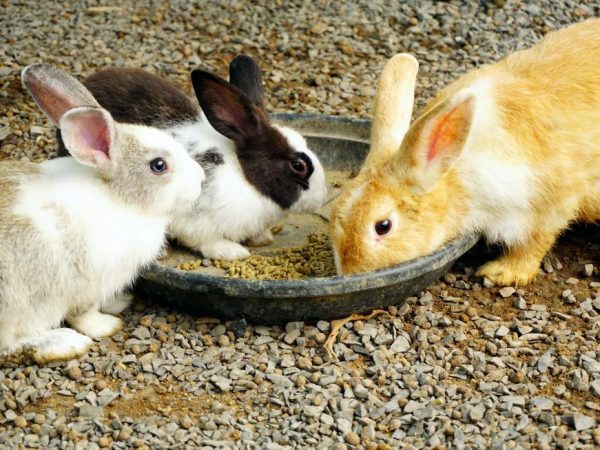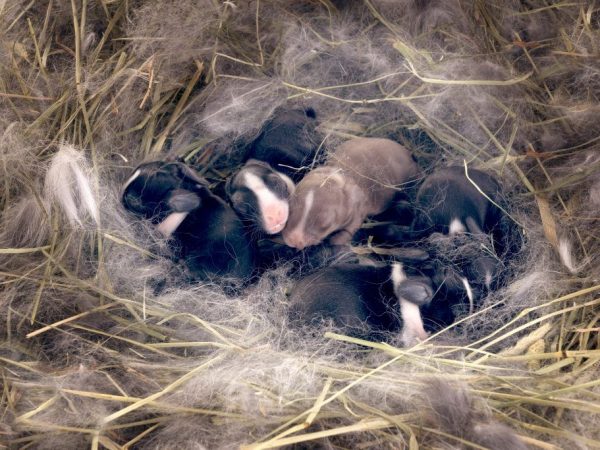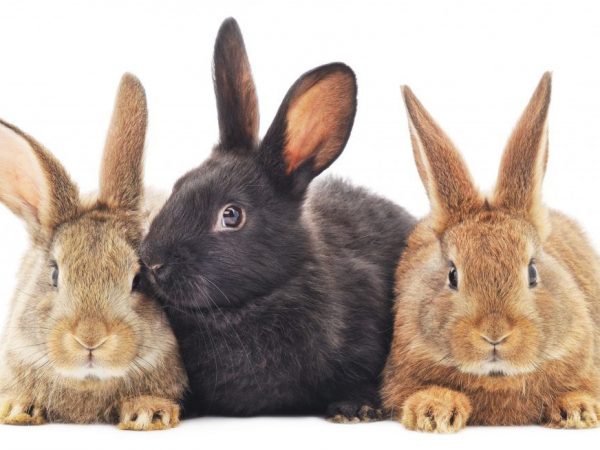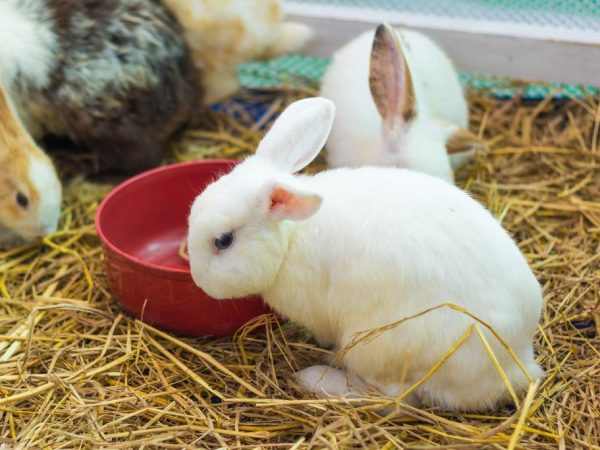At what age can rabbits be removed from the mother of the rabbit
Okrol is one of the most anticipated events on the farm for any breeder. However, the successful birth of rabbits is not a guarantee of good performance in meat and fur. Often inexperienced farmers are faced with various questions: how to feed a pregnant female, when to remove the young from the rabbit, after how many days will the rabbit be ready to mate again?

When to remove rabbits from mom
It should be noted that the jigging of rabbits is in no way connected with the last question: with a tight fertility schedule on the farm, the rabbit is again allowed to mate on the second day after giving birth. Very often, a nursing mother can be in the second or third week of pregnancy. Around the questions of how and when to remove the little rabbits from the rabbit, there is still debate among experienced rodent owners. There are several options to choose from, each of which has its own pros and cons. Let's try to understand everything in more detail.
At what age are bunnies separated from a rabbit
At what age are bunnies separated from a rabbit? Each rabbit owner answers this question differently. Throughout the practice of rabbit breeding, farmers have not come to a consensus. However, the procedure for jigging rabbits still has some rules and regulations. First, the period for which the pups should be weaned from their mother cannot be less than 24 days. The digestive organs have not yet been formed in babies, and the rabbits will die without mother's milk.
After the first 3 weeks of life, the baby teeth begin to change in the rabbits, and they try with interest the food that the rabbit eats. This behavior is due to the herd instinct: rabbits are happy to learn from each other. The female can have milk up to 12 weeks, but usually rabbits do not feed the offspring for such a long period.
If the age of the rabbits has already passed 40 days, they are able to partially feed themselves, and even begin to have an active sex life. It is important not to miscalculate this moment, because the female female should not be less than 6 months old. Otherwise, her body simply cannot cope with the stress.

At what age are rabbits separated from a rabbit
From the point of view of physiology, the optimal age when it is possible to remove the rabbits from the mother is considered to be 24 days from the birth of the rabbits. But such young growth usually grows weaker. Other breeders advise against jigging before 28 days.
This rush is due to the fact that there are 3 types of rounding charts on the farm:
- A tight divorce schedule is suitable for large fur-oriented farms.
- The semi-dense divorce schedule, due to its neutrality, allows you to raise offspring for the sale of all types of rabbit products.
- The sparse breeding schedule is focused on improving the quality of the meat and is suitable for boiler feeding.
With a tight mating schedule, the female is mated on the second day after giving birth. If you do not remove the rabbits from the pregnant female at the age of 28 days, then the rabbit simply will not have time to restore her strength and nervous system for a new birth.
If the little rabbit is already at least a month old, then they can be fed with compound feed and herbs. The cubs weigh about half a kilogram. This figure fluctuates depending on the breed and the saturation of the feed.
Bunnies, mating of which occurs according to a semi-compacted nesting schedule, can safely feed their offspring for more than a month. Mating with a male occurs in these rabbits in the second week after giving birth. The cubs of such a female are raised as future meat producers. Rabbits after weaning from their mother after 40 days are larger and stronger, and females give birth to healthy offspring.
Sometimes you can plant rabbits after 2 months from their birth. This so-called broiler jig produces better quality meat, but the birth rate will be much lower.
On large farms, they usually alternate methods of settling rabbits from rabbits or individually select them in accordance with the requirements for the offspring and the purpose of its further use.
Rules and methods for jigging rabbits from the mother
In order to minimize stress for both the young and the mother, you need to adhere to certain rules for jigging rabbits. In order to better carry out this simple procedure, it is necessary to carefully study the methods of jigging.
There are 3 types of them:
- One-time jigging of the entire litter from the rabbit at once, when they were 1.5 months old. Babies no longer need more milk by this time and will practically not experience stress. In order to finally reduce the threat of nervous experiences in the offspring, you can let the rabbit go once every few days.
- Jigging of a nursing female. The advantage of this method is that the cubs remain in their usual place. There is no threat of new noises and smells.
- Gradual deposition of offspring. He considers this method to be the most optimal, but quite a lot of trouble is associated with it. Weaker individuals remain in the nest for another 2-3 days, and strong ones are transplanted into cages. This method allows you to fatten all the rabbits to normal and has a beneficial effect on the rabbit.
- With gradual weaning, her milk will flow evenly, which reduces the threat of mastitis. But it should be borne in mind that on large farms, okrol often occurs in several females, and it is quite difficult to manage to distribute all the rabbits. So this method of jigging is suitable for small farms.

Rules for jigging rabbits
Females rarely have problems with jigging rabbits, they are quite calm about their cubs and pay them attention only twice a day. After weaning, rabbits should be immediately sorted into meat and breeding rabbits - this contributes to the selection of an individual diet and conditions of detention.
Measuring calf parameters after jigging
Once the deposition procedure has been carried out, the parameters of the rabbits should be measured. There are many ways to analyze metrics, but a beginner should focus on weight, gender, and health first. Weaker individuals are placed in separate cages, because the brothers can begin to crush the defective rabbit. Those lagging behind in weight gain should be transferred to a diet with increased nutritional value. Thus, in a couple of weeks they will be able to catch up with their relatives.
With a period of 45 days, weak babies can be given crushed concentrated feed without coarse fiber. This will help improve the absorption of nutrients.
Place for settling rabbits
First of all, you need to equip the place where the offspring is planned to be transplanted. You should worry about this in advance.
To determine the new place of residence of the rabbits, you need to remember that these eared animals are herd animals and cannot live alone.Females are seated separately from males for the first 2 months, while you need to be careful: the young are quite cocky, and therefore fights often break out for territory. If this began to happen in the cage, the pets should be seated in different houses.
Baby rabbits need to be in cages and aviary, which must be thoroughly disinfected. In the first months of life, young animals are extremely vulnerable to various infectious diseases. The dwelling of pets should be spacious; in crowded conditions, various unpleasant diseases can also develop and bones become deformed. The bottom of the cages should be wood or plastic. Sawdust or straw is usually used as bedding. So that weaning does not cause unnecessary stress to the cubs, it is necessary to mix part of the straw from the nest with fresh and cover the tray with such a mixture: the native smell will soothe the rabbits.
It is also important to carefully monitor the quality of the grass that is laid on young rabbits: sometimes insects and parasites come across it.
A dwelling for rabbits must be selected taking into account how many of them were born in the litter. Rabbits born from different females can be kept in the same enclosure. It is important that they are the same age. There should be no more than 3 animals per cubic meter.
What to feed the rabbits after leaving the mother
The diet of small rabbits should be given special attention: it should be nutritious and not overloaded. The stomachs of the young are not yet completely ready to accept plant food, so the feed should be given as light as possible. At the same time, rabbits need to gain weight from something, because they grow extremely quickly.

How to feed little rabbits
It is necessary to pay increased attention to babies in the first 1.5 months of their life. At this time, they molt, and they are especially vulnerable to stomach diseases. Young rabbits are fed 3 times a day in small portions. In this case, the compound feed must be finely chopped. In the first 2-3 weeks, experienced farmers recommend giving the same feed that the female ate during lactation. Other types of complementary foods, especially green ones, should be introduced very carefully so as not to rip the stomach of the ears.
You should refrain from such types of grains as wheat or barley: they clog the intestines and provoke diarrhea. The best cereals for young animals are oats and rye. After a certain time, you can start giving vegetables and fruits.
Conclusion
During this period, it is important to properly balance the diet. If the rabbits do not have enough minerals and vitamins in the feed, they should be replenished artificially.
The necessary complex of additives can be purchased at a pet store, not forgetting to consult a veterinarian before that: he will tell you exactly at what age newborn rabbits are removed from the mother of a rabbit and how to do it correctly.
So, when and how to remove the baby rabbits from the nursing rabbit, each breeder decides for himself, but certain rules and methods of jigging still exist. If you follow them, you can minimize stress in both the mother and the cubs.
The conditions of detention and a properly selected diet will help fluffy pets calmly survive the process of weaning from their mother, and for females - to continue to produce new offspring.


